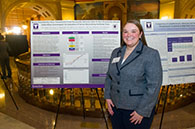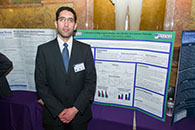Two graduate students recognized at statewide summit for research that benefits Kansas
Monday, Feb. 25, 2013
MANHATTAN -- Two Kansas State University graduate students have been named KansasBio winners for their research presentations at the 10th annual Capitol Graduate Research Summit.
Kelly Foster, master's student in biomedical sciences, Gardner, and Feraidon Ataie, doctoral student in civil engineering, Kabul, Afghanistan, each received a $500 scholarship from KansasBio. They will present their posters at the Kansas City Area Life Sciences Institute's annual dinner on May 7.
"We are very proud of Kelly and Feraidon and the seven other graduate students who represented Kansas State University at the Capitol Graduate Research Summit," said Carol Shanklin, dean of the Graduate School. "The summit provides our students with the opportunity to present their research and to demonstrate to legislators, the Kansas Board of Regents and community members how their work is making a difference in Kansas. All nine students did an exceptional job in representing the university and the quality of the research being conducted by our students and their faculty mentors."
The Feb. 14 summit at the State Capitol building featured Kansas-related research conducted by graduate students at Kansas State University, the University of Kansas, the University of Kansas Medical Center and Wichita State University. The students shared their findings with state legislators, the Kansas Board of Regents, industry representatives and other attendees. Two students from each university were chosen as scholarship winners.
Foster's poster was titled "Bovine viral diarrhea virus transmission from persistently infected cattle to non-persistently infected cattle when commingled: An evaluation of serum neutralizing antibody titers." Her faculty mentor is Daniel Thomson, Jones professor of epidemiology and production medicine and professor of clinical sciences.
Foster's research focuses on understanding how bovine viral diarrhea virus is passed from persistently infected cattle to naive cattle on farms where these animals are commingled. Nearly 1 percent of all cattle are born persistently infected with the virus and serve as a virus reservoir in cow herds and feedlots in the U.S. Foster conducted a 28-day trial to collect and analyze samples for the virus presence. She later analyzed the serum neutralizing antibody titers from samples collected prior to, during and on the final day of the study. She found that animals with high starting titers had shorter viremia and a decreased virus load. Those with the highest titers were refractile to infection. Additionally, naive cattle picked up the virus from the persistently infected cattle within 24 hours of exposure. Foster's research indicates the importance of proper immunization of cattle before entering the feedlot.
"Bovine viral diarrhea virus is a biologically and economically important disease that impacts cattle in Kansas," Foster said. "The virus causes compromising of the immune system, leading to other diseases, such as bovine respiratory disease complex. These diseases cause economic losses because of decreased cattle performance and mortality losses in the beef industry. Our research will provide insight on bovine viral diarrhea virus prevention and biosecurity management to improve cattle health and producer profitability."
Ataie's poster was titled "Utilization of high lignin residue ash (HLRA) in concrete materials." His faculty mentor is Kyle Riding, assistant professor of civil engineering.
Ataie's research focuses on concrete, the most used material after water. Concrete is made from three major components: portland cement, water and aggregate. Because portland cement is a highly energy intensive material, the cement industry is responsible for about 5 to 8 percent of global carbon dioxide emission. Ataie's research focuses on developing a new generation of supplementary cementitious materials that is highly reactive, environmentally friendly and can be widely available at low cost to replace some of the portland cement used in concrete. To accomplish this goal, Ataie is using byproducts of the bioenergy industry to produce a new class of highly reactive supplementary cementitious materials.
"The state of Kansas is a large producer of corn stover, a great resource for bioenergy production," Ataie said. "My research could contribute in lowering the cost of bioenergy production as well as producing environmentally friendly and high quality concrete materials for use in Kansas and throughout the nation."


